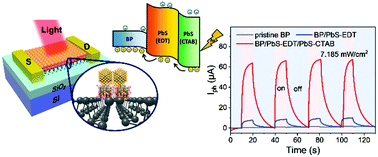Cascade-type energy band design of a black phosphorus photodetector with high performance
Abstract
The hybrid-induced photogating effect using colloidal quantum dots is usually utilized to optimize the performance of 2D-based photodetectors, where the 2D material is usually black phosphorus, transition metal dichalcogenides or graphene. However, the method of integrating a single-layer light absorber material with 2D materials for increasing the photoresponse has suffered from limited depletion width so it can hardly achieve our desired application. Here, we proposed a hybrid BP/lead sulfide quantum dot photodetector with a cascade-type energy band structure, which can greatly improve the performance of this photodetector compared with a single-layer absorber. This device can display a high responsivity of 1.1 × 107 A W−1, a high detectivity of 1.75 × 1015 Jones, and a low noise equivalent power of 4.3 × 10−7 pW Hz−1/2 simultaneously. These results indicate that a cascade-type energy band structure is not only able to effectively enhance the performance of the hybrid BP/lead sulfide quantum dot photodetector but also has great potential for wide application in other 2D material-based optoelectronic devices.



 Please wait while we load your content...
Please wait while we load your content...